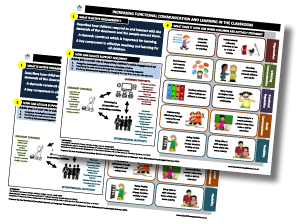For many years, educators have spoken about how structuring activities to foster ‘engagement’ results in learners becoming self-motivated to interact with the content of lessons resulting in deeper and more memorable learning experiences…
Why are education professionals so interested in active engagement?
When children are ‘actively engaged’ in a task then the process of learning becomes more motivating to the learner than completing the task. Intrinsic motivation is a powerful driver; learners independently seek out more information about a topic, make deeper and more meaningful connections between new and existing skills and knowledge, explore task materials and seek collaboration with other learners to solve problems.
What does neuroscience tell us?
Research into learning has found that when children are intrinsically motivated to learn, then the brain’s reward centre is extremely active, releasing the neurotransmitter, dopamine. Dopamine has a unique effect on the memory centres of the brain. When learners are exposed to information whilst dopamine is being released, then they are more likely to be able to remember and recall that information. You just have to compare children’s somewhat incredible ability to remember the names of a seemingly endless list of Pokémon characters and yet struggle to remember the names of 3D shapes learnt in a maths lesson!
What does active engagement look like?
Until recently, educational professionals have not had a clear idea about what active engagement looks like, but a pioneering study to explore how teachers can foster greater levels of active engagement for autistic children in their classrooms has shed some light on what it means to be actively engaged. This study defines active engagement as a set of five behaviours that pupils spontaneously demonstrate during activities relate to higher levels of active engagement.
Social communication provides the fuel for active engagement
In the same study, educators and researchers worked together to modify learning activities so that children were encouraged to be more responsible for organising their learning materials, had more opportunities to collaborate with their peers and were given more visual content so that children could talk about what they were learning with each other. In a randomised control trial, those pupils who were given modified activities displayed more behaviours associated with active engagement than those pupils who were exposed to more traditional, teacher-directed methods of teaching.
What does that mean for my classroom?
A few small modifications in your teaching style can result in significant changes in the way that children learn. Start small and try to build one of the suggestions below into each lesson. Use the list below to see if there are any changes in the way that children talk about and show how they’re acquiring new skills and knowledge. For children with SEN, who may have challenges with social communication, language learning or emotional regulation, a Speech and Language Therapist or Educational Psychologist may be able to offer more specialist strategies which enable these children to participate in the classroom as much as their peers.
5 Ways of getting pupils more involved in their learning
- Use written learning objectives and learning schedules at the start of each lesson and then ask pupils to discuss them with each other at the end of the lesson.
- Incorporate movement into learning! Research suggests that children who use gesture whilst completing maths problems, role play during literacy and are allowed to organise and manipulate task materials show a deeper understanding of subjects.
- Build resilience by giving feedback to children about their efforts rather than their intelligence! Children who are praised for the effort they put into learning are more likely to try new things than children who are not told by adults that they are ‘clever’.
- Create unpredictability and excitement! When you’re asking questions in class, prick out children’s names from a cup of lollypop sticks with their names written on them. Be aware that this can cause some stress for children so ensure that you allow kids to respond with ‘give me a clue’ or ‘I want to ask a friend’ scripts!
- Try to create a conversation with children rather than teaching being ‘on directional’. Leave spaces for children to finish the ends of sentences or ask children to become the teacher and talk about text or diagrams on the blackboard to the rest of the class.
Resources

Visit The Link at www.speechandlanguage.info to download this poster for Active Engagement.
Please login to view this content
Login